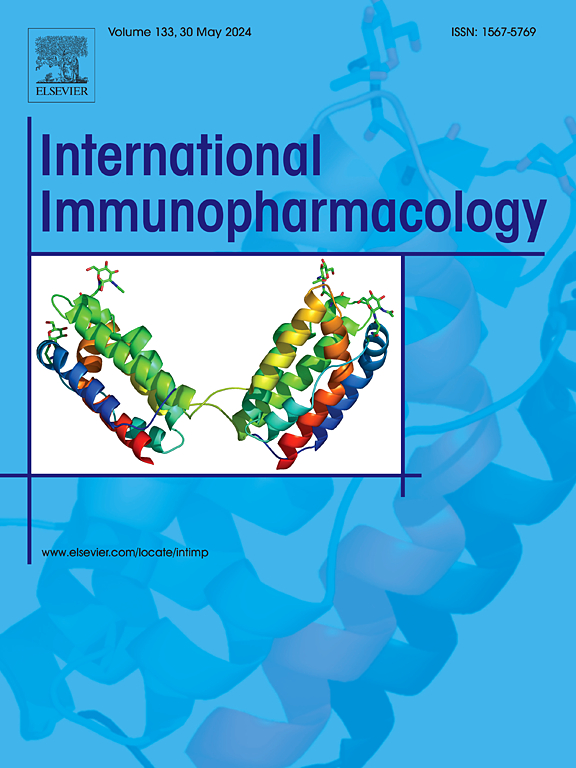Genetic analysis of diagnostic and therapeutic potential for ferroptosis in postoperative sepsis
IF 4.8
2区 医学
Q2 IMMUNOLOGY
引用次数: 0
Abstract
Background
Ferroptosis is a new form of iron-dependent cell death that is closely associated with sepsis. However, few studies have investigated the diagnostic and therapeutic potential for ferroptosis-related genes (FRGs) among postoperative sepsis.
Methods
The GSE131761 dataset was used to identify differentially expressed FRGs (DE-FRGs). KEGG and GO analyses were subsequently performed. LASSO and SVM-RFE methods were applied for identifying genetic biomarkers for sepsis. Gene set enrichment analysis (GSEA) and gene set variation analysis (GSVA) were applied for exploring the biological properties of the DEGs. CIBERSORT was applied to analyse immune cell infiltration. DGldb was employed for predicting potential target drugs for the DEGs. Competing endogenous RNA (ceRNA) networks were constructed to analyse the regulatory patterns of the DEGs. The expression of hub genes was validated based on GSE26440 dataset. The bioinformatics analysis was carried out with R software (version 4.1.2). Blood from sepsis patients and healthy controls was collected and the expression of hub genes was experimentally verified by real-time quantitative polymerase chain reaction (RT–qPCR).
Results
38 sepsis-associated DE-FRGs were assessed via Gene Expression Omnibus (GEO) and Ferroptosis database (FerrDb), and the gene function analysis showed that they were closely related to inflammatory response and autophagy regulation. Subsequently, SVM-RFE and LASSO methods determined 7 marker genes. GSEA suggested that these marker genes may be involved in regulating several biological pathways. Furthermore, 52 gene-targeted drugs were identified in this study, the vast majority of which were associated with MAPK14. CIBERSORT analysis suggested that SLC38A1, MGST1, and MAPK14 may be involved in immune microenvironment alterations. We revealed the potential complex regulatory relationship by constructing a ceRNA network based on marker genes. Finally, 6 genes were validated in the validation set, with 5 of them further confirmed through RT–qPCR.
Conclusion
Seven genes associated with ferroptosis are screened from postoperative sepsis samples. The expression of these genes has high diagnostic validity for sepsis and may serve as potential diagnostic biomarkers. This study gives an entrance point to uncover the underlying mechanisms of sepsis.

脓毒症术后铁下垂诊断和治疗潜力的遗传分析。
背景:铁下垂是一种新的铁依赖性细胞死亡形式,与败血症密切相关。然而,很少有研究探讨铁中毒相关基因(FRGs)在术后脓毒症中的诊断和治疗潜力。方法:使用GSE131761数据集鉴定差异表达FRGs (DE-FRGs)。随后进行KEGG和GO分析。采用LASSO和SVM-RFE方法鉴定脓毒症的遗传生物标志物。采用基因集富集分析(GSEA)和基因集变异分析(GSVA)对其生物学特性进行了研究。应用CIBERSORT分析免疫细胞浸润。DGldb用于预测deg的潜在靶药物。构建竞争内源RNA (ceRNA)网络来分析deg的调控模式。基于GSE26440数据集验证hub基因的表达。采用R软件(4.1.2版)进行生物信息学分析。采集脓毒症患者和健康对照者的血液,采用实时定量聚合酶链反应(RT-qPCR)验证hub基因的表达。结果:通过Gene Expression Omnibus (GEO)和Ferroptosis数据库(FerrDb)对38个脓毒症相关DE-FRGs进行评估,基因功能分析显示它们与炎症反应和自噬调节密切相关。随后,SVM-RFE和LASSO方法确定了7个标记基因。GSEA表明这些标记基因可能参与调节多种生物学途径。此外,本研究共鉴定出52种基因靶向药物,其中绝大多数与MAPK14相关。CIBERSORT分析提示SLC38A1、MGST1和MAPK14可能参与免疫微环境的改变。我们通过构建基于标记基因的ceRNA网络揭示了潜在的复杂调控关系。最后在验证集中对6个基因进行验证,其中5个基因通过RT-qPCR进一步确认。结论:从术后脓毒症样本中筛选出7个与铁下垂相关的基因。这些基因的表达对脓毒症具有很高的诊断有效性,可能作为潜在的诊断生物标志物。这项研究为揭示败血症的潜在机制提供了一个切入点。
本文章由计算机程序翻译,如有差异,请以英文原文为准。
求助全文
约1分钟内获得全文
求助全文
来源期刊
CiteScore
8.40
自引率
3.60%
发文量
935
审稿时长
53 days
期刊介绍:
International Immunopharmacology is the primary vehicle for the publication of original research papers pertinent to the overlapping areas of immunology, pharmacology, cytokine biology, immunotherapy, immunopathology and immunotoxicology. Review articles that encompass these subjects are also welcome.
The subject material appropriate for submission includes:
• Clinical studies employing immunotherapy of any type including the use of: bacterial and chemical agents; thymic hormones, interferon, lymphokines, etc., in transplantation and diseases such as cancer, immunodeficiency, chronic infection and allergic, inflammatory or autoimmune disorders.
• Studies on the mechanisms of action of these agents for specific parameters of immune competence as well as the overall clinical state.
• Pre-clinical animal studies and in vitro studies on mechanisms of action with immunopotentiators, immunomodulators, immunoadjuvants and other pharmacological agents active on cells participating in immune or allergic responses.
• Pharmacological compounds, microbial products and toxicological agents that affect the lymphoid system, and their mechanisms of action.
• Agents that activate genes or modify transcription and translation within the immune response.
• Substances activated, generated, or released through immunologic or related pathways that are pharmacologically active.
• Production, function and regulation of cytokines and their receptors.
• Classical pharmacological studies on the effects of chemokines and bioactive factors released during immunological reactions.

 求助内容:
求助内容: 应助结果提醒方式:
应助结果提醒方式:


